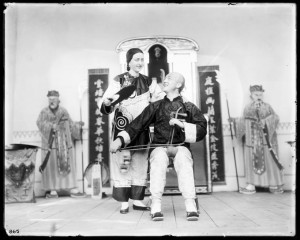Moorhouse Photography Collection: Judgement in Cataloging

Working in the Digital Scholarship Center as a student image cataloger, I have been exposed to multiple collections that are being digitized and shared on Oregon Digital. One of the primary collections I have worked with is the Lee Moorhouse photograph collection. Moorhouse was a photographer in the Pacific Northwest around the turn of the 20th century. He had a wide range of photographic subjects, but two prominent ones I have come across are the touring shows that came to Pendleton, OR and various Native Americans in the Pacific Northwest. At the turn of the century some of the vaudeville acts that performed in Pendleton had a heavily racist element in their show. In his photography of Native Americans, Moorhouse would pose his models with a hodgepodge of Native American objects, part of a tradition of white artists’ creating stereotyped representations of Native Americans. As the cataloger of these photographs, it was my responsibility to add accurate and relevant subject headings that would help researchers find them. Often, I could easily identify and record the subject matter of a photograph. However, in these troubling photos, how do I accurately describe what these images are?

In collections management, the job of an image cataloger is not to offer curatorial judgement, but to best preserve and record objects in an institution’s collection. I struggled when faced with these troubling images. If I don’t recognize the racism present in these photos, am I doing a disservice to those that use Oregon Digital or do I not include such a description to maintain objectivity? I was most struck by this dilemma when I began cataloging photos of a vaudeville act that used what can be called “yellow face” to mock Chinese immigrants. I decided that the subject heading of racism was appropriate here as it is not based on judging the people in the photo, but on the actual theme behind their performance. Also I had to consider how these photos would be most relevant to a researcher. With one of the performers mock smoking opium, I thought it was clear that these photos would be most relevant today to someone researching racism in vaudeville acts. By including racism as a subject heading I would make these photos easier for a researcher to find and I would be accurately recording them in Oregon Digital.

It was clear to me that the vaudeville photos needed to be recorded as demonstrating racism, but the photos of Native Americans posed a more difficult question. I chose not to add the subject heading of racism to the staged portraits of Native Americans. I thought it went too far into a curatorial perspective of these images. While it can be argued that such representations of Native Americans are racist, there was no direct evidence within the photo itself that led me to believe that the photographer or the model was racist. As opposed to the photos of the vaudeville act, which was clearly mocking Chinese immigrants and used “yellow face.” The stereotypes represented in the Moorhouse photos are problematic, but no unarguable elements existed within Moorhouse’s Native American portraits that made me comfortable labeling them as racist. Instead, I decided to label these photos, “staged photography.” That subject heading demonstrates that these photos are not accurate representations of these people, but are instead holding props and wearing costumes that Moorhouse dressed his models in.
In working with the UO Libraries digital collections, I have learned that thoughtfulness is critical in how an institution categorizes items in its collection. As an image cataloger I am not supposed to apply curatorial judgement, but I am supposed to accurately describe items in our collections. By thinking about how the public will perceive digital collections, both myself and other catalogers learn how to make items more accessible, and thus useful, to the public.
By Mason Moorman
Student Image Cataloger
Digital Scholarship Center
UO Libraries
All photographs (1888-1916) are from the Lee Moorhouse (1850-1926) collection.

